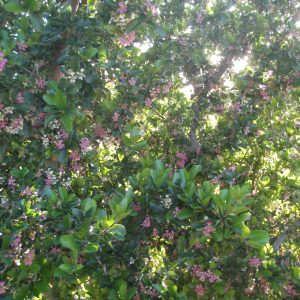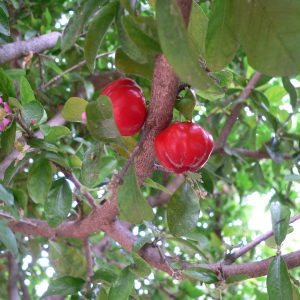Malpighia emarginata
Acerola, Barbados cherry, West Indian cherry
Origin
This neo-tropical species has been distributed to other tropical and sub-tropical regions worldwide, with Brazil having the largest plantings.
Climate
It can be grown in tropical and sub-tropical areas provided there is regular adequate moisture. Native areas receive about 1700mm/yr precipitation with temperatures of 15-32°C preferred. There is little tolerance to frost, particularly when young, and temperatures below 10°C prevent growth.
Plant Description
It forms a many-branched evergreen shrub or small tree if pruned to a single trunk, 2-5m high. There is a shallow root system and branches have short lateral spurs. Elliptical-ovate entire glossy glabrous leaves are simple, opposite, 1-4 X 2-6cm, dark green on the upper surface & lighter underneath. Young leaves are pubescent and irritating to some people, whereas mature leaves are glabrous. The species is diploid and in sweet varieties the leaves are more undulated.
Relatives
The genus Malpighia contains about 40 species and is a member of the Malpighiaceae family with about 1300 species. The two most common binomials for acerola are M emarginata (7 synonyms) and M glabra (14) with some common to both as in the past they have been difficult to robustly classify using morphological features. However modern molecular techniques reveal small differences in genetic markers between them. Other fruiting species in the family include peanut butter fruit and nance.
Soils
Soil pH of 5.5-7 is ideal but it will grow in almost any kind provided it is well-drained. If nematodes are a problem, this should be addressed before the tree is planted.
Propagation
Seed germination is epigeal phanerocotylar and best with 2 days fermentation to remove pulp followed by complete removal from the pyrene, but success rate is low. Seedlings are highly heterozygous, their quality is generally poor, and are recommended only for breeding purposes. Grafting (side veneer or cleft) is usually practiced only when cuttings of a desired clone are scarce, or when top-working a tree that bears fruits of low quality, or if a nematode-resistant rootstock is available on which to graft a preferred cultivar. Plants are best propagated from hardwood cuttings. They should be dipped in a rooting hormone (eg IBA) and will take about 8 weeks to strike.
Cultivars
There are two general types – acid and sweet. B17 and Red Jumbo are acid types while, Florida Sweet, Manoa Sweet and Hawaiian Queen are sweet. Florida Sweet is probably the easiest one to source in WA.
Flowering and Pollination
Young trees can commence flowering within two years, and in tropical climates will flower many times throughout the year, independently of photoperiod. Inflorescences primarily on old growth are mainly axillary, sometimes terminal cymes, usually with 3-5 sessile 2-2.5 cm wide, white-pink flowers having 5 petals, 10 stamens, a superior ovary, 3 styles and 3 fused carpels. Anthesis occurs very early in the mornings and flowers only last a day. They don’t have sugar-producing nectaries but rather elaiophores, & pollination in native areas is an example of pollinator and flowering morphology/behaviour co-evolution. Large solitary native bees in the neotropics (mainly Centris) have the right size and oil foraging behaviour for effectiveness. In WA, bees, other insects and perhaps wind are the main pollinators, but none is very effective; other flowering plants are more attractive to honeybees than acerola. The species is only partially self-fertile; hand pollination will improve fruit set and yield, and cross-pollination is also beneficial. Some fruit can set parthenocarpically.
Cultivation
Acerola prefers full sun as shading will reduce yield. Young plants are tender to cold and may need some protection in winter. Adequate watering is necessary during bloom and fruit development; in drought conditions it will adopt a deciduous habit. It is sensitive to water salinity but effects can be reduced with a slight increase in N & P application. Alkaline calcareous soils above pH 7 will need micronutrient supplementation, and acid soils below pH 6 should have lime worked into the soil down to 20 cm or more. NPK should be applied as several applications throughout the year, and the use of mulch is recommended. Mycorrhizal associations are formed, assisting nutrient absorption.
Wind Tolerance
Cutting grown plants with only shallow laterals for support can be blown over whereas seedlings with taproots are more resistant. Branches are brittle.
Pruning
Pruning to the desired form should be undertaken when young. Height is easily contained as the plant matures, with light pruning after harvests.
The Fruit
With optimal conditions, fruit ripen very quickly (25-35days). The attractive glossy orange more commonly red skinned soft oblate three-lobed fruits (3-14g) are drupes with orange flesh. They have thin skin and are easily bruised. There are three pyrenes, each containing a single seed. Fruit can be quite tart, due to the high concentrations of malic and ascorbic acids (vitamin C). Flesh pH is 3-3.3 in acid type fruit, slightly higher in sweet, and vitamin C is higher in the acid types at about 2500mg/100g in ripe fruit – ie 50 times that of oranges. Brix in sweet types is 9-10%.
Fruit Production and Harvesting
Cutting grown plants may fruit in the first year after planting, with yield steadily increasing over the next several years. In Puerto Rico, four-year old plants have been reported to produce 15-30kg/tree. The fruit should be picked every 2-3 days before they’re fully ripe as they don’t keep well on the tree. Fruit are highly perishable, with a limited storage life of 2-4 days at room temperature.
Fruit Uses
The fruits can be eaten fresh, made into juice, jam, jellies, wine, sherbet, and many desserts.
Pests and Diseases
Relatively free of fungal diseases, scale and fruit fly problems, but birds, aphids, weevils, mealy bugs and nematodes may need attention.
Comments
Acerola is an easily-grown plant that can crop well with adequate watering and hand-pollination, and could be an attractive feature in the garden. It can easily be grown in pots.

